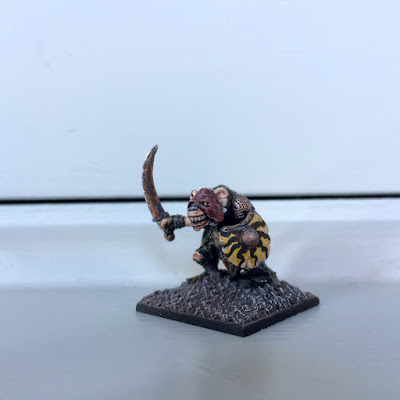Here's another batch of beastmen for my MicroHotT project. These will all be 'horde' elements in MicroHotT.
The ability to churn out horde elements quickly is a big part of the appeal of MicroHotT. Some of these kitbashes were originally destined for regular HotT horde elements that I started work on a couple of years back. I got five done - but I've knocked out ten MicroHotT elements in a fraction of the time. The reason's obvious: a MicroHotT element is a single figure, whereas most of my HotT horde elements contain at least five.
We played another game of MicroHotT at the weekend. The joy of this version of the game is being able to use very large numbers of elements without overwhelming the table. We played with about 64 AP each, but found that a single PIP roll (1-6 PIPs) worked fine.
Because you can split groups at will, as in any version of HOtT, you get a constant stream of command-and-control decisions. Those are a often a bit more crucial than in HotT, because you're having to assess the relative threats of various blocks: "Will six warband elements be a match for the fourteen hordes over there, or should I keep the group of ten together to make sure?"\
The only downside that I've noticed so far is that it looks a little odd when you have a single spear or warband element backed up by another. The aesthetics are better in standard HotT, because you get a square group rather than a tiny column. But in practice, it happens rarely and not for long: if you have two warbands fighting one, it makes more sense for one of the two to overlap or flank than to provide rear support (there's a greater chance of a kill with +3 vs +2 than with +4 vs +3, as the chances of doubling are higher). And, of course, you're normally fighting with much larger groups of elements than this.
An idea I tried out in our latest game was using "double-based" elements to represent very large monsters - or, rather, monsters that don't fit comfortably on a 25mm frontage. I happen to have a couple of beasties based in that way from an abortive Mayhem project a few years back (we ended up just playing it with doubled-up HotT elements). And I also have a giant painted to match my Nick Lund orcs that fits nicely onto a temporary 50 x 50mm base.
Using these beasts (two behemoths and a dragon) required a slight adjustment to the rules. Here's what I came up with:
1. Double elements cost twice the points of a normal element minus one (for 1-2AP elements) or minus two (for 4-6AP elements). So a double warband costs 3 (like the unofficial brute and phalanx rules) and a double dragon costs 6. The lower cost represents the fact that a double element is less manoeuvrable and thus less flexible than two single elements. For example, two ordinary dragons can range the battlefield mopping up hordes and other vulnerable foes, while a single "double dragon" will take a lot longer to do so. A double element can't "close the door" as two single elements could. Also, double behemoths, dragons and gods, etc., can flee, flee off the battlefield or dematerialise at a stroke, whereas two dragons, etc., would be likely to last longer.
2. Double elements can attack twice per bound if they are in front-edge-to-front-edge contact with two enemy elements. If they are in such contact with a single element, they automatically overlap it. So a double dragon fighting a single warband element is on +6 vs +2.
3. Double elements only suffer the negative consequences of close-combat outcomes if they receive only negative or neutral outcomes in a given bound. So, a double dragon that is beaten by one element but destroys or pushes back another does not flee from the table. A double element that is doubled by one opponent and merely beaten by the other is destroyed. A doubling and a draw result in a kill, and a beating and a draw result in a recoil (or fleeing the table for a dragon). Positive outcomes work as normal (a double element won't pursue if it's still in contact with a foe).
4. When double elements fight each other, they fight as normal elements of their kind. So a double dragon vs a double behemoth is +6 on +5 with normal outcomes.
All of this sounds a bit fiddly, but it worked just fine. The doubled elements were a lot harder to defeat in close combat, but they could still be flanked and destroyed by determined foes. The points costing felt about right.
The doubled troop types allow me to use monsters that are a bit two big for Warhammer-sized cavalry monsters but slightly underwhelming on an conventional HotT 60mm frontage. And using appropriately sized bases keeps the miniatures more suitable for other games - notably RPGs - which is one of the main goals of MicroHotT. The swelling horde below is just screaming for a dungeon to populate ...








These are great... true chaos that Moorcock would approve of.
ReplyDeleteThanks! I'm musing over various leader-types that might offer a whiff of Jagreen Lern or Gaynor the Damned. And I'm planning on having the Ganh (the flying shark from the Corum books) to lead the chaos pack ...
DeleteWhat Springinsfeld said! Wow!
ReplyDeleteThanks! Lots more to come!
Delete